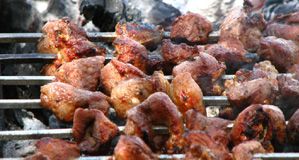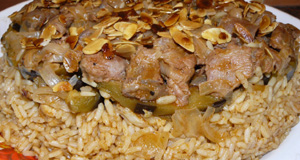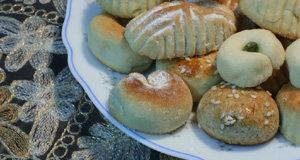|
Arabic cuisine in general is influenced by the nomadic Bedouins, and especially the cuisine of Lebanon, Syria and Palestine. Jordan's cuisine is part of this culinary heritage, and shares many of the characteristics. Within the Arabic culture food is an important aspect and used to express hospitality and generosity.
The national dish of Jordan is Mansaf, a Bedouin dish. A lamb with aromatic herbs is cooked in dried yoghurt (jameed), served with rice and garnished with pine or other nuts. It often symbolizes an occasion like a wedding, and as with most Bedouin dishes, it is traditionally eaten with the right hand.
Another popular dish is Maglouba, made with lamb or chicken and aubergines, sometimes fried cauliflower. Maglouba is translated as "Upside Down", cause this casserole is inverted after preparation. A special experience is Zarb, a Bedouin dish. Meat, mostly lamb, is cooked by a unique underground grilling method in a mud oven, served with rice and vegetables. Very similar is Mandi, usually made with a young lamb cooked in a special kind of clay oven. Dry wood is placed in the oven, burnt to charcoal, then then meat will be put inside and the whole oven closed so that no smoke escapes.
Most popular in Arabic cuisine are the starters, known as mezze. Well known is Falafel, a fried ball or patty made from spiced chickpeas and/or fava beans. A popular appetizer is hummus, a puree of chick peas blended with tahina (pulped sesame seeds), lemon and garlic. Kibbeh is a fried ball with a meat and bulgur wheat paste as crust and an aromatic filling of meat. The primary ingredients of tabbouleh, a salad, are finely chopped parsley, bulgur, mint, tomato, scallion, and other herbs with lemon juice, olive oil and various seasonings like black pepper. Fattoush is a seasonal salad made from several larger vegetable pieces, herbs and toasted or fried pieces of pita bread. Foul consists of mashed, brown fava beans, and moutabel is a spicy aubergine dip.
National specialties are Kebabs, consisting of grilled or broiled meats on a skewer or stick. The most common kebabs include lamb and beef. Shish taouk is made by skewering and grilling cubes of chicken. An originally Palastenian dish is Musakhan composed of chicken in olive oil and onion sauce roasted on Arab bread. A popular rice dish is Kabsa, mainly made from a mixture of spices, rice, vegetables and meat, such as chicken, goat, lamb, camel. Waraq Enab are grapevine leaves stuffed with rice, minced meat and spices. Mainly in Aqaba you find Sayadiya, fish cooked in layers of rice, fried onions gives it the taste and the brown color.
An Arabic food experience is only completed with a dessert. Baklava is a rich, sweet pastry made of layers, filled with nuts and sweetened with honey. Kanafa is a pastry filled with nuts or goats cheese. It consists of a base layer made of cheese mixed with milk or cream, a crispy layer of dried noodles and often topped off with some syrup. Ataif is a small fried pancake filled with nuts or cheese and traditionally eaten during Ramadan. A classic dessert is Mohallabiya, a rice pudding perfumed with rose water or orange, flavoured with spices and garnished with nuts.
Hospitality in the Arab world is expressed by serving a mint tea or a freshly-brewed coffee to every guest. Arabic coffee is strong, served in small cups, sometimes with a taste of cardamom. Although Jordan is mainly a Muslim country, thanks to the Christian minority, the country has a long tradition of wine-production, popular is Mt. Nebo Wine. Another production is Araq, an aniseed-flavoured liquor, usually mixed with water and ice. |




|